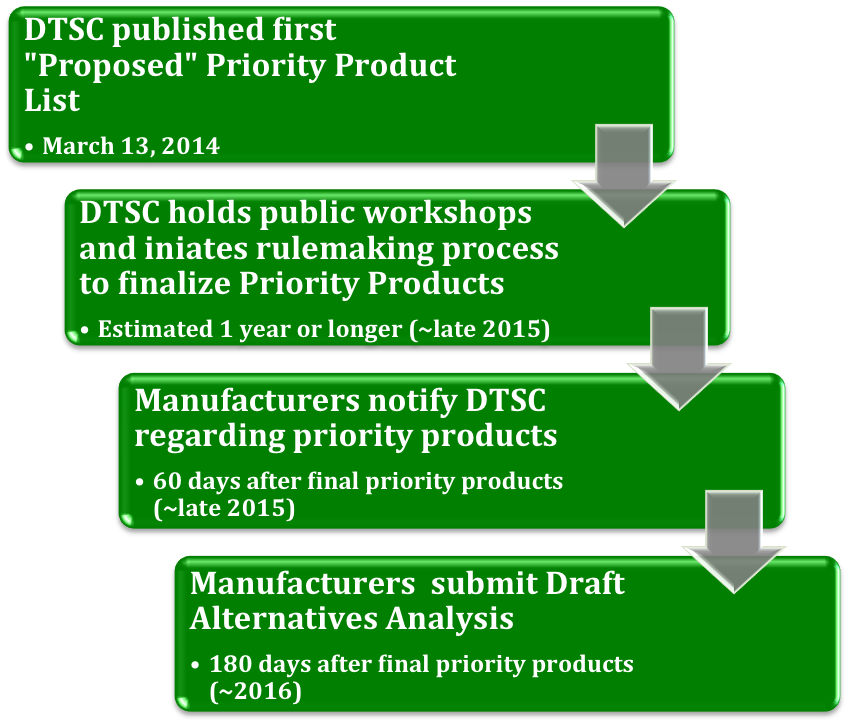California’s Safer Consumer Product Regulations “seek to reduce toxic chemicals in consumer products.” There are over 1000 candidate chemicals (“toxic chemicals”) that have been identified from lists published by authoritative organizations. DTSC identifies priority products for regulation that contain one or more of the candidate chemicals generally based on potential hazard and exposure to consumers. Once priority products are finalized through a formal rulemaking process, manufacturers of those products must notify DTSC and begin an alternatives analysis process that may result in removing the candidate chemicals(s) from the product, identifying a better substitute, or demonstrating that no safer, viable alternative is available. DTSC’s web page provides more detailed information: https://dtsc.ca.gov/SCP/PriorityProducts.cfm
PRIORITY PRODUCTS
DTSC published the first “Proposed” Priority Products on March 13, 2014. The first three priority products are:
- Paint and varnish strippers and surface cleaners containing methylene chloride
- Spray polyurethane foam systems containing unreacted diisocyantes
- Children’s foam-padded sleeping products containing TDCPP (tris[1,3-dichloro-2-propyl]phosphate)
These first priority products are only proposed at this point and will not be finalized until 2015 or later after a series of public workshops followed by a formal rulemaking process. Once final, manufacturers of these priority products will need to notify DTSC within 60 days and conduct a draft Alternatives Analysis within 180 days. ToxStrategies staff can help you navigate this new and developing regulatory program. This process is summarized in Figure 1.
PRIORITY PRODUCT WORK PLAN
In April 2015, DTSC issued the final Priority Product Work Plan, Three Year Work Plan (2015-2017) (Work Plan) that describes the criteria and timeframe for identifying additional priority products beyond the initial three. DTSC identified the following six product categories from which future priority products will be selected:
- Beauty, personal care, and hygiene products
- Building products and household, office furniture and furnishings
- Building products: Painting products, adhesives, sealants, and flooring
- Household/office furniture and furnishings
- Cleaning products
- Clothing
- Fishing and angling equipment
- Office machinery (consumable products)
In the Work Plan, DTSC also identified some key chemicals in these products, which include: bisphenols, chlorinated and brominated organic compounds in flame retardants, formaldehyde, metals, phthalates, and toluene.
ALTERNATIVES ANALYSIS GUIDE
In September 2015, California’s Department of Toxic Substances Control (DTSC) released their “Draft Stage 1 Alternatives Analysis Guide” (AA Guide) as part of their Safer Consumer Products (SCP) program. This program focuses on specific chemicals (chemicals of concern) in specific consumer products (priority products) in an effort to identify safer alternatives. The AA guide is intended to “provide useful approaches, methods, resources, and tools to help responsible entities fulfill the regulatory requirements for the AA.”
The guidance addresses Stage 1 of the two-stage AA process. As part of Stage 1, the responsible entity conducts a preliminary analysis, which includes an initial evaluation and screening of alternative replacement chemicals as well as development of a work plan to complete a more in-depth analysis during the second stage of the AA process. Following regulatory review of the Stage 1 Preliminary AA Report, Stage 2 is the implementation of the work plan leading to a final decision regarding the chemical of concern in the priority product. A draft including Stage 2 of the analysis process is scheduled for release in 1st quarter 2016.
FIGURE 1 – Implementation of Safer Consumer Products Regulations*

